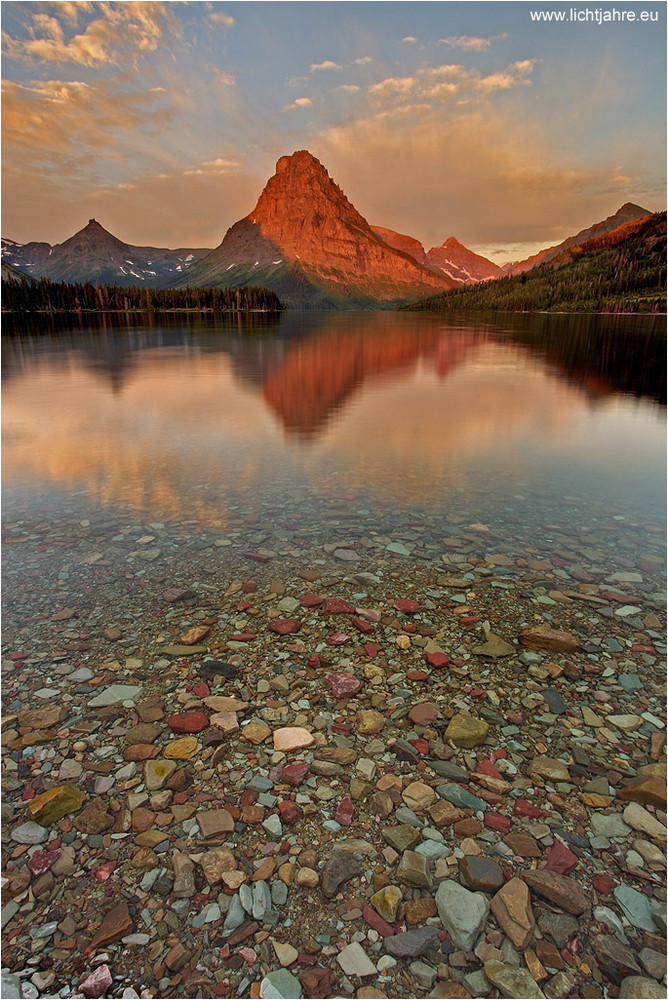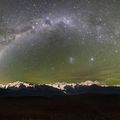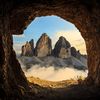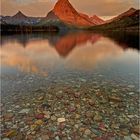Ancient Shorelines
Die erhabene Landschaft der Rocky Mountains in Waterton Glacier besteht aus mindestens 1.5 Milliarden Jahre altem Gestein. Zu dieser Zeit war der archaische amerikanische Kontinent ein karges Land mit flachen Meeren, Flüssen und Schlamm. Cyanobakterien erbauten die ersten Riffe auf Erden, die zu Stromatolithen versteinerten. Wellen-schlag erzeugte Rippelmarken die bis heute erhalten blieben. Sogar winzige Einschlagkrater von Regentropfen im Schlamm sind deutlich im Gestein sichtbar. Eine Momentaufnahme aus einer Welt 1000 Millionen Jahre bevor die ersten Tiere das Licht der Welt erblickten. Entlang einer Nord-Süd Achse driftete der Kontinent hier wiederholt auseinander. Dies formte ein tiefes Grabensystem in dem die Sedimente der Belt Rocks bis zu 21 km Mächtigkeit erreichten. Vor 750 Millionen Jahren driftete der archaische Westen Amerikas davon und bildete die Antarktis. Die nördlichen Rocky Mountains bestehen aus diesen Belt Rock Sedimenten und hoben sich vor 80 Millionen Jahren. Die Berge spiegeln sich in Gletscherseen, die vor zwei Millionen bis 10.000 Jahren während der letzten Eiszeit enstanden.
August 2008
Canon 20D, Canon 10-22mm, f/22, 2 Sek, 100 ASA, Stativ
Mehr Information unter
www.lichtjahre.eu
Where Geoscience Meets Art - Die Ästhetik der Geowissenschaft
Ein Projekt, das die Schönheit der Natur dokumentiert
und zum Verständnis der Geowissenschaften beiträgt
----------------------------------------------------------------------------------------
The sublime landscape of the Rocky Mountains in Waterton Glacier originates from bedrock older than 1.5 billion years. At that time the archaic North American continent was a barren land with shallow seas, streams and mud. Cyanobacteria built the first reefs on Earth that fossilized into stromatolithes. Wave action formed ripple marks outlasting eons of time. Even tiny impact craters of raindrops in the mud are preserved in these rocks. A snapshot from a world 1000 million years before the first animals would appear. Here, the continent repeatedly started and failed to split apart along a north south trough. This formed a rift valley where sediments from the surrounding land accumulated to a total thickness of 13 miles (21 km) making it one of the largest sediment deposits on Earth, called the Belt rocks. 750 million years ago the western part of ancient North America drifted away forming an own continent today known as Antarctica. The Northern Rockies we know today consist of Belt rock sediments. The uplifting started 80 million years ago. The mountains reflect in glacial lakes originating from the last ice age two million to 10.000 years ago.
August 2008
Canon 20D, Canon 10-22mm, f/22, 2 sec, ISO 100, tripod
More information:
www.lichtjahre.eu
Where Geoscience Meets Art
A project that documents Nature's beauty
and enhances understanding of geosciences













Dagli 02/01/2012 23:09
TOP!Die Perspektive, die Spiegelung, die Wolkenstimmung und die Kieselsteine im Vordergrund! Klasse Bild!
LG
Melih
Steffen Dittrich 22/07/2011 7:32
Fantastisches Bild in klasse Farben und sehr gelungenem Schnitt. Auch die Perspektive gefällt mit sehr gut.LG Steffen
Roland.H 05/03/2009 13:53
wunderschöne Aufnahme, gefällt mir sehr.LG Roland
LichtEinheit 05/03/2009 12:27
ungewönlicher Schnitt + Perspektivegefällt mir sehr vom Motiv
Bild etwas kleiner kalibrieren ?! ( auf meinem Monitor muss ich scrollen ?!)
LG LichtEinheit